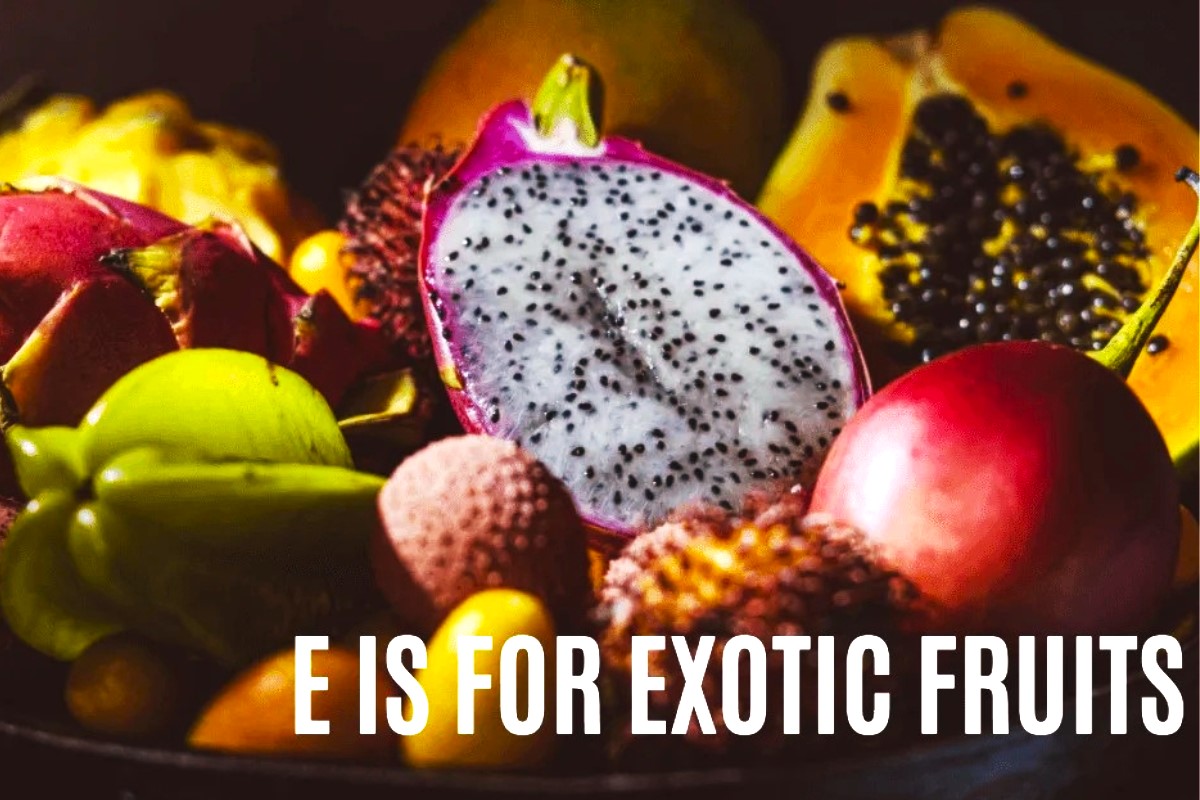Home>Food and Cooking>10 Unique Foods That Start With The Letter “U”


Food and Cooking
10 Unique Foods That Start With The Letter “U”
Published: January 28, 2024
Explore 10 unique and delicious foods that start with the letter "U" in this comprehensive guide. From udon to umeboshi, satisfy your culinary curiosity! Discover recipes and cooking tips.
(Many of the links in this article redirect to a specific reviewed product. Your purchase of these products through affiliate links helps to generate commission for Noodls.com, at no extra cost. Learn more)
Ube
Ube, also known as purple yam, is a versatile and vibrant ingredient that has been a staple in Filipino cuisine for generations. Its rich purple hue and subtly sweet flavor make it a highly sought-after ingredient in both savory and sweet dishes. The word "ube" is derived from the Tagalog language, and it is pronounced as "oo-beh."
In Filipino culture, ube holds a special place, often used in traditional desserts such as ube halaya, a sweet and creamy purple yam pudding that is commonly enjoyed during special occasions and holidays. The process of making ube halaya involves grating the purple yam and cooking it with condensed milk, coconut milk, and butter until it reaches a smooth and thick consistency. This beloved dessert is often garnished with grated cheese on top, creating a delightful blend of sweet and savory flavors.
Beyond desserts, ube is also utilized in savory dishes, adding both a unique color and a hint of sweetness to various recipes. Ube can be incorporated into bread, pastries, ice cream, and even beverages, showcasing its versatility in the culinary world. Its natural purple pigment adds an enchanting visual element to any dish, making it a favorite among food enthusiasts and social media influencers alike.
In recent years, ube has gained popularity beyond Filipino cuisine, making its way into trendy eateries and dessert shops around the world. Its captivating color and delightful taste have made it a sought-after ingredient for chefs and food artisans looking to elevate their creations with a touch of exotic flair.
Whether it's in the form of ube-flavored cakes, cookies, or even ube-infused beverages, this remarkable ingredient continues to captivate taste buds and inspire culinary innovation. With its growing global presence, ube has undoubtedly become a symbol of creativity and diversity in the vibrant tapestry of international cuisine.
Udon
Udon, a type of thick wheat flour noodle, holds a significant place in Japanese cuisine and is celebrated for its delightful chewy texture and versatility in various dishes. These noodles are a staple in Japanese comfort food, often enjoyed in a steaming bowl of broth or stir-fried with an assortment of fresh ingredients.
The preparation of udon noodles involves a meticulous process of kneading wheat flour, salt, and water to form a smooth and elastic dough. The dough is then rolled out and cut into thick strips, giving the udon noodles their signature width and substantial bite. The noodles are then boiled until they reach the perfect al dente texture, ready to be incorporated into a myriad of culinary creations.
One of the most iconic udon dishes is "Kake Udon," where the noodles are served in a delicate yet flavorful broth made from dashi, soy sauce, and mirin. This simple yet satisfying dish is often garnished with thinly sliced scallions or tempura, adding depth and texture to the overall dining experience.
In addition to being served in hot broth, udon noodles are also commonly enjoyed cold, particularly during the summer months. "Zaru Udon" features chilled udon noodles served on a bamboo mat, accompanied by a dipping sauce made from soy sauce, mirin, and dashi. This refreshing dish is often garnished with grated daikon radish and nori, offering a delightful contrast of flavors and temperatures.
Udon noodles are also a popular addition to stir-fries and hot pots, adding a hearty and satisfying element to these dishes. Their ability to absorb the flavors of accompanying ingredients makes them a versatile and beloved component in Japanese cuisine.
Beyond their traditional roots, udon noodles have gained global popularity, finding their way onto the menus of diverse restaurants worldwide. Their comforting texture and ability to complement an array of flavors have made them a favorite among food enthusiasts seeking a taste of authentic Japanese cuisine.
Whether enjoyed in a steaming bowl of broth or as part of a creative culinary fusion, udon noodles continue to captivate diners with their comforting appeal and rich culinary heritage. As a beloved symbol of Japanese gastronomy, udon noodles stand as a testament to the enduring allure of traditional comfort foods in an ever-evolving culinary landscape.
Umami
Umami, often referred to as the fifth taste, is a flavor profile that is deeply savory, rich, and profoundly satisfying. Discovered and named by Japanese chemist Kikunae Ikeda in the early 20th century, umami has since become a fundamental concept in the world of culinary arts and gastronomy.
The term "umami" originates from the Japanese word for "deliciousness," and it is used to describe the unique taste sensation that is distinct from sweet, sour, salty, and bitter. This savory flavor is attributed to the presence of glutamate, an amino acid that naturally occurs in various foods, as well as inosinate and guanylate, which enhance umami when combined with glutamate.
Umami is commonly found in a wide range of ingredients, including tomatoes, mushrooms, aged cheeses, soy sauce, and cured meats. It is also prevalent in certain seafood such as fish sauce and seaweed, adding depth and complexity to dishes.
The allure of umami lies in its ability to elevate the overall flavor profile of a dish, creating a harmonious balance that tantalizes the taste buds. When incorporated thoughtfully, umami-rich ingredients can transform a simple meal into a culinary masterpiece, leaving a lasting impression on those who partake in its indulgence.
Chefs and food enthusiasts around the world have embraced the concept of umami, recognizing its potential to enhance the dining experience. By harnessing the power of umami-rich ingredients, culinary artisans can create dishes that resonate on a profound sensory level, evoking feelings of comfort, satisfaction, and culinary delight.
In recent years, the appreciation for umami has extended beyond traditional culinary practices, influencing the development of new flavor profiles and innovative cooking techniques. The integration of umami-rich elements in fusion cuisine and modern gastronomy has led to the creation of bold and inventive dishes that captivate the palates of discerning diners.
As the culinary landscape continues to evolve, umami remains a cornerstone of culinary excellence, inspiring chefs to push the boundaries of flavor exploration and culinary innovation. Its profound impact on the world of food and cooking serves as a testament to the enduring influence of taste and flavor in shaping our culinary experiences.
Unagi
Unagi, a delicacy in Japanese cuisine, refers to freshwater eel that is celebrated for its rich, succulent flavor and tender texture. This prized ingredient holds a revered status in traditional Japanese culinary practices, where it is often showcased in a beloved dish known as "Unadon" or "Unagi Donburi."
The preparation of Unagi involves a meticulous process that begins with the filleting and deboning of the eel, followed by its grilling over a charcoal fire. The grilling process is a crucial step that imparts a smoky aroma and caramelized glaze to the eel, enhancing its natural flavors and creating a delightful contrast of textures.
Unadon, a quintessential Unagi dish, features a bed of steamed rice topped with grilled Unagi fillets that have been glazed with a sweet and savory tare sauce. The combination of tender eel and seasoned rice creates a harmonious blend of flavors and textures, offering a truly indulgent dining experience.
The allure of Unagi lies not only in its exquisite taste but also in its cultural significance within Japanese gastronomy. Unagi holds a special place in Japanese culinary traditions, particularly during the midsummer festival known as "Doyo no Ushi no Hi," where it is believed to provide nourishment and vitality to combat the oppressive summer heat.
Beyond its cultural significance, Unagi has garnered international acclaim, captivating the palates of food enthusiasts and culinary connoisseurs worldwide. Its unique flavor profile and culinary versatility have inspired innovative interpretations and creative culinary fusions, showcasing the eel's ability to transcend cultural boundaries and delight diverse audiences.
As a testament to its revered status, Unagi continues to be cherished as a symbol of culinary excellence, captivating diners with its exquisite taste and timeless appeal. Whether enjoyed in a traditional Japanese setting or as part of a modern gastronomic creation, Unagi remains a cherished delicacy that embodies the artistry and heritage of Japanese cuisine.
Ugli fruit
Ugli fruit, despite its unappealing name, is a tropical citrus fruit that offers a delightful blend of flavors and a vibrant burst of sunshine to the palate. This exotic fruit, also known as the uniq fruit, is a hybrid of tangerine, grapefruit, and orange, combining the best attributes of each citrus variety into a single tantalizing fruit.
The ugli fruit's rough, wrinkled exterior may not exude the same visual allure as its citrus counterparts, but beneath its unassuming facade lies a treasure trove of juicy, tangy-sweet goodness. Its thin, easy-to-peel skin gives way to segments of succulent flesh that are refreshingly juicy and bursting with a harmonious balance of sweetness and tartness.
The flavor profile of the ugli fruit is a symphony of citrusy notes, with hints of tangerine, grapefruit, and orange dancing on the taste buds with each juicy bite. Its luscious flesh is a testament to the natural abundance of tropical flavors, offering a refreshing and invigorating experience that evokes images of sun-drenched orchards and balmy breezes.
Beyond its exceptional taste, the ugli fruit also boasts a wealth of nutritional benefits, making it a wholesome addition to a balanced diet. Rich in vitamin C, fiber, and antioxidants, this unassuming fruit packs a powerful punch of nutrients, contributing to overall health and well-being.
The versatility of the ugli fruit extends to its culinary applications, where it can be enjoyed in a myriad of ways. Whether savored on its own as a refreshing snack, juiced for a zesty beverage, or incorporated into both sweet and savory dishes, the ugli fruit lends its vibrant flavors to a diverse array of culinary creations.
Despite its humble appearance, the ugli fruit has carved a niche for itself in the world of exotic fruits, captivating the palates of adventurous food enthusiasts and culinary aficionados. Its unique combination of flavors, nutritional benefits, and culinary versatility makes it a prized gem in the realm of tropical fruits, offering a taste of paradise in every delectable bite.
Umeboshi
Umeboshi, often referred to as "Japanese salt plums," holds a revered status in Japanese culinary traditions and is renowned for its bold, tangy flavor and vibrant red hue. These pickled plums are derived from ume fruits, which are closely related to apricots and possess a unique combination of sourness and subtle sweetness. The process of making umeboshi involves carefully salting the ume fruits and allowing them to ferment and pickle over several weeks, resulting in a distinctive flavor profile that is both intensely sour and salty.
In Japanese cuisine, umeboshi is cherished for its ability to add a burst of flavor and complexity to various dishes. These pickled plums are commonly enjoyed as a condiment alongside steamed rice, where their tangy acidity serves as a palate-cleansing counterpart to the richness of other dishes. Umeboshi is also a key component in making umeboshi onigiri, a popular rice ball snack that features a filling of pickled plum wrapped in seasoned rice and seaweed, offering a delightful blend of textures and flavors.
Beyond its culinary applications, umeboshi is revered for its potential health benefits and medicinal properties. In Japanese culture, umeboshi is often regarded as a natural remedy for digestive ailments and fatigue, believed to aid in digestion and provide a boost of energy. The high citric acid content of umeboshi is thought to contribute to its potential health-enhancing properties, making it a cherished ingredient with a multifaceted appeal.
The bold and distinctive flavor of umeboshi has transcended traditional Japanese cuisine, inspiring innovative culinary applications and creative interpretations in modern gastronomy. Chefs and food artisans around the world have embraced the unique tanginess of umeboshi, incorporating it into dressings, marinades, and sauces to infuse dishes with a zesty and invigorating kick.
As a testament to its enduring appeal, umeboshi continues to captivate the palates of food enthusiasts and health-conscious individuals, offering a tantalizing balance of flavor and potential wellness benefits. Whether enjoyed in its traditional form or as part of inventive culinary creations, umeboshi stands as a testament to the timeless allure of pickled delicacies and their enduring place in the diverse tapestry of global cuisine.
Upma
Upma, a beloved South Indian dish, holds a cherished place in the culinary tapestry of the region, celebrated for its comforting simplicity and delightful blend of flavors. This versatile dish, often enjoyed as a wholesome breakfast or snack, is crafted from semolina (also known as rava or sooji) and an assortment of aromatic spices and vegetables, resulting in a dish that is both nourishing and satisfying.
The preparation of upma begins with toasting the semolina in ghee or oil, allowing it to develop a subtle nuttiness and golden hue. The toasted semolina is then combined with a fragrant mixture of mustard seeds, curry leaves, chopped onions, green chilies, and ginger, infusing the dish with layers of savory and aromatic notes. The addition of finely diced vegetables such as carrots, peas, and bell peppers further enhances the texture and flavor profile of the upma, creating a vibrant and wholesome medley of ingredients.
One of the defining characteristics of upma is its ability to adapt to various flavor profiles and culinary preferences. While the classic version of upma embodies the earthy warmth of traditional spices and vegetables, creative variations have emerged, incorporating ingredients such as cashews, raisins, and grated coconut to add depth and complexity to the dish. The versatility of upma allows for endless experimentation, making it a canvas for culinary innovation and personalization.
The appeal of upma lies not only in its delightful flavors but also in its nourishing qualities, making it a popular choice for a hearty and wholesome meal. Its balanced combination of carbohydrates, proteins, and essential nutrients provides sustenance and energy, making it a favored choice for breakfast or a light, yet fulfilling, midday meal.
Beyond its cultural roots, upma has transcended regional boundaries, captivating the palates of food enthusiasts and health-conscious individuals worldwide. Its simplicity, versatility, and nourishing attributes have positioned it as a beloved dish that resonates with a diverse range of culinary preferences and dietary lifestyles.
Whether enjoyed in its traditional form or as part of modern culinary interpretations, upma continues to embody the timeless allure of comfort food, offering a taste of South Indian culinary heritage and the heartwarming embrace of a wholesome and flavorsome dish.
Uszka
Uszka, which translates to "little ears" in Polish, are delicate and delectable dumplings that hold a cherished place in the rich tapestry of Polish culinary traditions. These petite dumplings are characterized by their unique ear-like shape and are traditionally filled with a savory mixture of finely chopped mushrooms and onions, creating a symphony of flavors and textures in every bite.
The process of crafting uszka is a labor of love, requiring patience, precision, and a deep appreciation for culinary artistry. The dough, typically made from flour, egg, and water, is meticulously rolled out and cut into small squares, which are then carefully folded and pinched to form the distinctive ear shape. The filling, often consisting of a fragrant blend of sautéed mushrooms, onions, and seasonings, is nestled within the tender embrace of the dumpling, creating a harmonious union of flavors and textures.
One of the most iconic presentations of uszka is in the traditional Polish dish known as "barszcz z uszkami," where the dumplings are served in a clear beetroot-based broth. This classic combination of vibrant beetroot soup and tender uszka dumplings offers a delightful contrast of flavors, with the earthy richness of the mushrooms harmonizing with the subtle sweetness of the broth.
Beyond their traditional accompaniment with barszcz, uszka have also found their way onto the tables of festive gatherings and celebratory feasts, where they are showcased as a symbol of culinary craftsmanship and hospitality. Their diminutive size and intricate appearance make them a visually captivating addition to any spread, evoking a sense of warmth and conviviality.
The enduring appeal of uszka extends beyond their cultural significance, as they have garnered international acclaim, captivating the palates of food enthusiasts and culinary adventurers around the world. Their exquisite blend of flavors, meticulous craftsmanship, and cultural heritage make them a beloved symbol of Polish gastronomy, offering a taste of tradition and a glimpse into the heart and soul of Polish culinary artistry.
Whether enjoyed in a traditional setting or as part of a modern culinary interpretation, uszka continue to embody the timeless allure of handcrafted delicacies, inviting diners to savor the artistry and heritage encapsulated within each tender, savory morsel.
Udon
Udon, a type of thick wheat flour noodle, holds a significant place in Japanese cuisine and is celebrated for its delightful chewy texture and versatility in various dishes. These noodles are a staple in Japanese comfort food, often enjoyed in a steaming bowl of broth or stir-fried with an assortment of fresh ingredients.
The preparation of udon noodles involves a meticulous process of kneading wheat flour, salt, and water to form a smooth and elastic dough. The dough is then rolled out and cut into thick strips, giving the udon noodles their signature width and substantial bite. The noodles are then boiled until they reach the perfect al dente texture, ready to be incorporated into a myriad of culinary creations.
One of the most iconic udon dishes is "Kake Udon," where the noodles are served in a delicate yet flavorful broth made from dashi, soy sauce, and mirin. This simple yet satisfying dish is often garnished with thinly sliced scallions or tempura, adding depth and texture to the overall dining experience.
In addition to being served in hot broth, udon noodles are also commonly enjoyed cold, particularly during the summer months. "Zaru Udon" features chilled udon noodles served on a bamboo mat, accompanied by a dipping sauce made from soy sauce, mirin, and dashi. This refreshing dish is often garnished with grated daikon radish and nori, offering a delightful contrast of flavors and temperatures.
Udon noodles are also a popular addition to stir-fries and hot pots, adding a hearty and satisfying element to these dishes. Their ability to absorb the flavors of accompanying ingredients makes them a versatile and beloved component in Japanese cuisine.
Beyond their traditional roots, udon noodles have gained global popularity, finding their way onto the menus of diverse restaurants worldwide. Their comforting texture and ability to complement an array of flavors have made them a favorite among food enthusiasts seeking a taste of authentic Japanese cuisine.
Whether enjoyed in a steaming bowl of broth or as part of a creative culinary fusion, udon noodles continue to captivate diners with their comforting appeal and rich culinary heritage. As a beloved symbol of Japanese gastronomy, udon noodles stand as a testament to the enduring allure of traditional comfort foods in an ever-evolving culinary landscape.
Ulluco
Ulluco, scientifically known as Ullucus tuberosus, is a vibrant and versatile tuber that has been cultivated for centuries in the Andean regions of South America. This lesser-known yet remarkable root vegetable boasts a kaleidoscope of colors, ranging from brilliant yellows and oranges to deep purples and reds, making it a visually stunning addition to culinary creations. The ulluco plant thrives in high-altitude environments, where it is celebrated for its resilience and nutritional value, offering a unique and valuable contribution to the rich tapestry of Andean cuisine.
The ulluco tuber, similar in appearance to a small, elongated potato, is prized for its crisp texture and subtly sweet flavor, which intensifies when cooked. Its versatility in the culinary realm is showcased through a myriad of preparations, including boiling, steaming, frying, and roasting, each method accentuating its unique attributes and yielding delightful results. Whether incorporated into stews, soups, or stir-fries, ulluco adds a delightful crunch and vibrant color to dishes, elevating both the visual appeal and flavor profile of the culinary ensemble.
In addition to its culinary appeal, ulluco is a nutritional powerhouse, rich in essential vitamins, minerals, and dietary fiber. Its vibrant hues are indicative of the presence of beneficial phytonutrients, contributing to its potential health-enhancing properties. As a resilient and sustainable crop, ulluco plays a vital role in the dietary and cultural heritage of Andean communities, offering sustenance and culinary inspiration while adapting to the demands of diverse environmental conditions.
Despite its relative obscurity on the global culinary stage, ulluco has garnered attention from culinary enthusiasts and sustainability advocates, sparking interest in its unique attributes and potential as a valuable addition to diverse culinary landscapes. Its rich history, vibrant colors, and culinary versatility position it as a captivating ingredient with the potential to inspire innovative culinary creations and foster a deeper appreciation for the diverse array of root vegetables found across the globe.
As the world continues to embrace culinary diversity and sustainable food practices, ulluco stands as a testament to the rich tapestry of agricultural biodiversity and the enduring allure of ancient crops that continue to captivate and inspire a new generation of culinary explorers.













